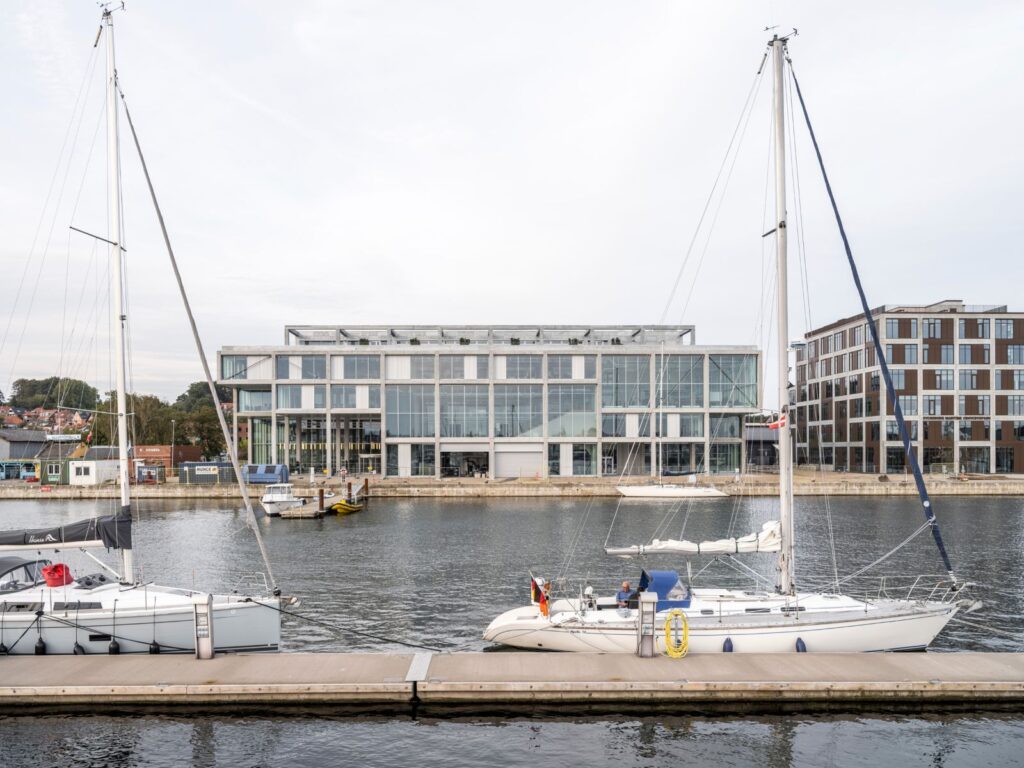C.F. Møller Architects and EFFEKT unveil maritime academy staged as a grid

In the old port and shipping town of Svendborg, Denmark, the largest maritime education institution in the country has risen along the harbour’s edge. Svendborg International Maritime Academy, or SIMAC, used to be spread out on several addresses around town, but has now been united in one building on the harbour front with teaching and study space for 1.000 students.
In a joint partnership Danish architecture studios C.F. Møller Architects and EFFEKT have designed the 12,500 m2 building in collaboration with Artelia. It unites the site’s various scales and architectural figures, such as cranes, container ships and clean, geometric industrial buildings, in a bold and distinctive concrete framework.
A spatial connection to the harbour and the city
The prefabricated concrete elements gather the load-bearing and spatial structure into a resilient grid of columns and girders. This approach maximizes the load-bearing capacity of the elements while reducing material consumption.
The facade plane is pulled back, so that the concrete grid manifests itself as the dominant element also in the external appearance of the education institution. The result is a simple and honest expression based on functionality and utilisation. The building’s transparent façade allows natural light to flood the interior in the daytime and as twilight sets, the building becomes a beacon, illuminating the harbour front.
According to Sinus Lynge, architect and co-founder of EFFEKT Architects, the idea was already present during the competition phase that the school should spatially connect to the harbour and the city, the industrial area, and the new residential area:
Public access all the way to the rooftop
The school opens up to its surroundings on all four corners. The upper floors jut out like tall canopies over the entrances allowing public access to the communal facilities, such as the building’s café and canteen, which are open to visitors whether they prefer to dine indoors or enjoy the outdoor square facing the harbour.
A communal rooftop terrace offers panoramic views of the harbour, Svendborg Sund, and the city while the quay itself becomes an outdoor laboratory that highlights the school’s work and maritime virtues.
Maximum flexibility in space utilization
Inside, SIMAC maintains an industrial aesthetic, with exposed concrete surfaces and durable floors built to withstand heavy use. Glass partitions connect the atrium with the teaching rooms, creating an atmosphere of openness and encouraging spontaneous interaction and collaboration among students and faculty. It was essential for the two architecture studios to ensure that SIMAC would be long-lasting.
The building’s modular construction grid allows for maximum flexibility in space utilization ensuring that classrooms, workshops, and offices can be reconfigured as needed without compromising the structural integrity. It was also a key concern to avoid superfluous materials, which is why everything is exposed, and no unnecessary ceilings, facades, or surface coverings have been used.
A framework for community and collaboration
At the centre of the building lies a spacious, light-filled 20-meter-high atrium that connects the various floors both visually and logistically. Four double-height areas surrounding the atrium house essential functions, such as a canteen, auditoriums, and specialized workshops. The staircase, a key element of the structure, leads to the communal rooftop terrace. This dynamic arrangement fosters a sense of community and collaboration within the building.
Part of a living district
The education institution forms part of a masterplan for a new district at the North Quay in Svendborg with the aim of transforming a 5,5 ha industrial area to a new living district with education, business, homes and recreational areas.
The opening of SIMAC marks the completion of the first stage of the masterplan, which includes a specific proposal for new urban green areas that will secure this part of Svendborg against any potential extreme rainfall in the future.
Location: Svendborg, Denmark
Architect: C.F. Møller Architects in collaboration with EFFEKT
Landscape: C.F. Møller Architects in collaboration with EFFEKT
Engineer: Artelia
Contractor: MT Højgaard
Client: SMUC Fonden with support from the A.P. Møllerske Støttefond.
Size: 11,800 m2
Year: 2019-2023
Photographs: Rasmus Hjortshøj, Courtesy of C.F. Møller
Photo © Rasmus Hjortshøj
Photo © Rasmus Hjortshøj
Photo © Rasmus Hjortshøj
Photo © Rasmus Hjortshøj
Photo © Rasmus Hjortshøj
Photo © Rasmus Hjortshøj
Photo © Rasmus Hjortshøj
Photo © Rasmus Hjortshøj
Photo © Rasmus Hjortshøj
Photo © Rasmus Hjortshøj
Photo © Rasmus Hjortshøj
Level 01 Floor Plan
Level 02 Floor Plan
Site Plan





